|
FAQs about Marine Crab Identification
2
Related Articles: Crabs, Hermit
Crabs,
Related FAQs: Crab
Identification 1, Crab ID 3,
SW Crab ID 4, SW Crab ID 5, SW
Crab ID 6, SW Crab ID 7, SW Crab ID 8, SW
Crab ID 9, Marine
Crab ID 10, Marine
Crab ID 11, Marine
Crab ID 12, SW Crab ID 13,
SW Crab ID 14, SW Crab ID 15, SW
Crab ID 16, SW Crab ID 17,
SW Crab ID 18,
SW Crab ID 19,
SW Crab ID 20,
SW Crab ID 21,
SW Crab ID
22,
& Marine Invertebrate identification,
Marine
Crabs 1, Marine Crabs
2, Marine Crabs 3,
Marine Crabs 4, Crab Behavior, Marine Crab
Selection, Marine Crab
Compatibility, Marine Crab
Systems, Marine Crab
Feeding, Marine Crab
Reproduction, Marine Crab
Disease, Micro-Crustaceans,
Amphipods, Copepods, Mysids, Hermit
Crabs, Shrimps,
Cleaner
Shrimps, Banded Coral
Shrimp, Mantis
Shrimp, Anemone
Eating Shrimp, Crustacean Identification, Crustacean Selection, Crustacean Behavior, Crustacean Compatibility, Crustacean Systems, Crustacean Feeding, Crustacean Disease, Crustacean Reproduction,
|
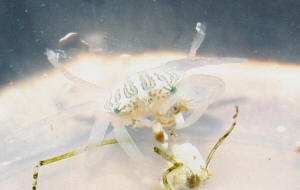
|
| Live Rock Hitchhiker crab 10/3/05
Hello! I've been reading and enjoying WWM for a long
time. After years of keeping various species of Loaches I've
finally add a 30g saltwater set-up to my collection of tanks. It is
a fish only w/live rock set-up and is fully cycled. It start off
slowly, I added trio of one inch long, tank bred Ocellaris
Clownfish, 5 Blue-legged Hermit Crabs, 5 Turbo Snails, 3 Bumblebee
snails, 2 Peppermint shrimp and 2 Skunk Cleaner shrimp. On the
first night the fish were in the tank one of the Clownfish
disappeared without a trace. Not even a piece of a corpse was left.
I thought perhaps the other 2 Clowns might have killed the third,
but then I spotted this crab lurking in my live rock and I began to
wonder if he might be the killer. He's a mottled greenish-brown
color, about the size of a dime and never seems to venture out of
the rocks. Any idea what he is and if he may have killed the Clown?
Thanks in advance for your help and for such a cool Web
site! Robin <Crabs are hard to ID, but they are
almost universally untrustworthy. The crab may not have
killed your clown, but between it and the bumblebee snails, they
could have made quick work of the carcass. I would
suggest trapping it. This is usually easily accomplished
by placing an upright baited glass in the tank with the edge of the
glass against the live rock. The crab will fall into the
glass seeking the bait, but will not be able to climb the smooth
walls to escape. Best
Regards. AdamC.> |
|
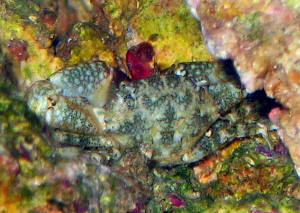
|
Crab ID Hi, I would be grateful if you could identify a
stowaway crab I got with my live rock as I'm scared it will eat my
fish when bigger. It has bright red eyes with white tentacle things
between eyes. It is dark and has legs that are not segments but each
one is one whole curve, it is always hiding in the rock and never goes
on substrate and has tiny white spots on claws. It was tiny but in
three months has grown to the size of a 2p[ence]. I don't know if
there is enough info there but please try your best. Thank you very
much for your time. <Tyrone, I will refer you to a Wet Web
link with some photos. You may be able to identify it there. With the
info provided, I haven't got a clue, sorry.
http://www.wetwebmedia.com/marine/inverts/arthropoda/crabs/swcrabs.htm
James (Salty Dog)>
|
Crabs? No thanks. 2/22/05 Hi guys!
<howdy> My first time writing...hoping you can maybe help
me ID a small crab I found on a piece of Xenia rock I just got in
here. Seems to be small and harmless (of course, those are the
ones that usually cause the most trouble!). <actually... crabs
are almost categorically indiscriminate omnivores and NOT reef
safe long term> He didn't seem to be bothering the Xenia
at all (pom-pom Xenia, if that makes a difference?). Body size is
about 1/4" in width right now. Mostly a whitish/translucent
color with small brownish to gray marking on the top of the
shell. <still a crab...> Was NOT happy about me pulling off
his Xenia! I'm hoping he's benign, and I'll gladly
add him to the tank (155g reef), but I don't want to cause
any problems. I've attached a couple pictures; first is with
the flash, second without. Thanks in advance! Fred
<remove this crab to a refugium or fish-only display tank to
be safe my friend. Anthony>
|
|

|
| Crab ID 12/31/04 here is another picture of the tiny
crab. Jackie <I am not sure what information you have
already received, but the ID of small crabs is generally difficult
since they are of little interest to anyone for intentional
collection for the aquarium trade or for food. As a
general rule, I take an "innocent until proven guilty"
attitude toward most hitchhikers, but not in the case of
crabs. Almost all crabs are opportunistic omnivores and
will eat just about anything that they find or can catch (including
other inverts and fish). Any unidentified crabs found in
my tanks are captured, killed and fed to my
anemones. Best Regards. AdamC.> |
|
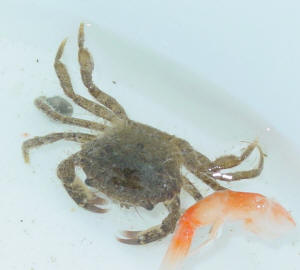
|
Furry Crab, White eyes - ID? 4/25/04 I'm trying to
find out what kind of crab this little tan furry guy is. <his
name is Frank> I found some info on teddy bear crabs, but this
guy has white eyes and white claws and a big mouth when he opens
it. <don't call him Teddy Bear or even "Frankie"
to his face... he hates that... he's a tough guy> He has
basically stayed within 4 to 5 inches of the same spot on the piece of
coral, <as most Xanthid crabs do> he seems to be
either pinching pieces of coral off or eating some thing growing on the
coral that I can't see. <your coral in the pic is mostly
dead... very poor health with little living tissue I can see>
I hope the picture helps. Thanks for your help. Neal <Xanthid
crabs may be harmful, helpful (commensal) or neutral. Alas I cannot say
from here. This is a good example of why it is so important to
quarantine all new livestock without exception. Beyond disease issues,
you can scan for pests and predators (bad worms, crabs, algae, etc) in
a safe isolation tank and not have situations like this with a
potential coral predator now loose in your tank and the coral's
tissue rotting in display water. Do check out our archive of articles
and FAQs on this and many other useful topics at wetwebmedia.com.
Anthony>
Crab ID 4/20/04 Hello Crew, <cheers>
I know this is a bad photo but hopefully with a good description
you help id this crab that came in my live rock, with reading about
and searching about crabs you here so many bad things about hitch
hikers kinda worries you when you are new to marine tanks. for a
description it is about the size of a dime , body is oval shaped
and a mottle brown and white, short legs that are brown and white
striped, and claws are large and of equal size, only distinct
feature on the claws other then being brown and white is they both
have a small red band on them. should I allow this crab to continue
life in my tank? <although we cannot ID this by species, one
look at the claws (if not knowing the general omnivorous behavior
of most all crabs) reminds us that form follows function: those
claws are not there for algae grazing. This crab like most all, is
not reef safe. Do remove it please> will my emerald Mithrax crab
eat him? <hard to say, although I suspect in the next year your
growing Mithrax is more likely to catch and kill a fish. No crabs
are truly reef safe> thanks again Drew
<kindly, Anthony> |
|
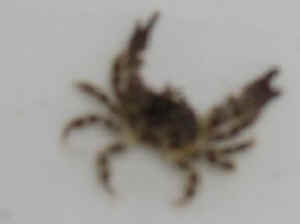
|
Crab ID? 12/5/03 Dear WWM Crew,
<howdy> My mini reef is almost two years old and like most
hobbyists I spend hours observing it, even at night.
<yes... fascinating> Three nights ago I was making my
periodic midnight inspection and laughing about how my Sixline
wrasse leaves his tail hanging out of one of his sleeping holes, a
pvc T supporting the rockwork. He used to fit when he
was smaller. Then I noticed that two red spots on the
rock nearby blinked at me, and here was this blackish brown crab
with white dots parked right between my wrasse's tail and a
scarlet hermit crab. <hmmm... do be careful here.
There really is no such thing as a reef-safe crab... all are
essentially opportunistic predators. When algae wanes, they often
get carnivorous> I have not added any rock of any size (The
original was all Fiji) for over a year and I can't believe that
I missed this guy (it is a male) the whole time. Never
even a molted carapace. It darted back into the
rock post haste after I hit with my light full on. I trapped it in
a glass baited with shrimp pellets last night
<excellent move... do remove to sump, refugium or another fish
only display> (along with four hermits, a gaggle of copepods and
two legs of my serpent star) It is now just over
3/4" across. See the attached pictures.
<alas... we cannot/will not open zipped files. Please send
web-sized smaller jpeg images when so> The front claws are
pretty big but distorted by the curvature of the glass to appear
larger. <make no mistake... form follows function.
Those claws exist for a reason> The back legs are all spike
feet, no swimming paddles and very slightly hairy, as well as being
noticeably shorter than a mithrax's. The body in
fact was larger relative to the legs than most crabs I've
seen. The carapace doesn't have spikes of any kind
just ridges on the edges, and is roughly elliptical in
shape. Instead of being spring-loaded in the pissed off
position like the blueclaws I used to wrangle on the Chesapeake
this guy seemed mortified by having a light shined on him and
balled up pulling all of his legs in tight. I wish I
could have gotten him to spread out and walk for a photo but at
least he left the other crabs and the starfish's legs
alone. I shooed out the starfish and spooned out the
other crabs and shot some pictures before releasing the mystery
crab into the fishless refugium. (Only one with flash
since the light seemed to wig him out so badly) Out of
the glass he finally realized he had legs again and got out of
sight in a hurry. I have not noticed any fish or coral
damage, or snail deaths since I got rid of my killer peppermint
shrimp a few months ago. (Thank you thank you thank you
Anthony for that advice. With War, Death and Pestilence
out if the tank and exchanged for a selection of the snails they
ate the tank is a much happier more mellow place.
<heehee... quite welcome. It is amazing how many folks recommend
the addition of Lysmata shrimp to reef tanks. Risky> Although
the 'pods are getting above themselves now and strut about in
the open like they don't have a thing to worry
about.) <ha! Any with felt caps and feathers?> So
I don't think that the crab has done any damage to this point,
but the large claws (and evil red eyes) worry me
somewhat. <indeed... a long term risk> I
couldn't find on this site or on the web a photo of exactly
this coloration and shape. Because of the large claws I
was hazarding a guess that it was a Xanthid of some flavor, but the
uniform colored (not black-tipped) claws and the shortish, smallish
legs look more box crab-like. Now I think it's
neither. <do look at some of the Portunids if you
like> Thus my question to you to see if you can help identify
it, or at least the family of crab that it is. It's
staying in the refugium alone in any case, except for some stray
Nassarius snails. <a wise move> Thank you very
much to all for the great site! Matt Dautle
<always welcome my friend... bets of luck. Anthony> |
|
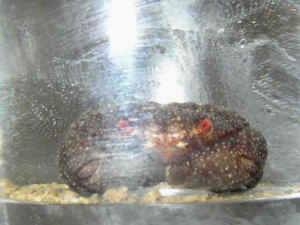
|
Crab ID? 12/5/03 <<do look at some of the Portunids if
you like>> I have! That family and Arenaeus,
Callinectes were my first match choices but all of them have the rear
legs modified as swimming paddles unless there is some sub-family that
I haven't seen. Carcinus, Menippe, Panopeus,
Rhithropanopeus - I'm seeing crabs and talking Latin in my sleep!
(What would a shrink make of THAT? Or Steven King?) It does
resemble a rock crab of some ilk except for the dots pattern, coloring
and that probably can be highly variable based on location even within
the same species. <yes... some semblance to Cancer or
Calappa in its stout posture> The exact identification is not
terribly important, but I thought you would like to see a picture in
case you hear of another crab matching this description. The
white dots are on the crab, not smudges on the glass, and the flash
gave him turbo red-eye, but there were red to begin with too.
<almost as scary looking as those can opener claws. In time, snails,
bivalves/clams and/or fishes are clearly not safe with this crab>
I'm sure that you're correct in the assessment that as he got
larger he would have been sampling reef critters that I would like to
keep intact. The claws are twice as fat as a Mithrax of the
same size although I never observed him to do anything with them except
keep them tightly tucked against his body. <understood.
Form follows function though... and those sturdy appendages are for
chipping at shell> If he gets bigger on the diet of algae, junk and
the occasional shrimp pellet he'll find in the refugium I'll
try to coax him out again for more pictures. I'm still
amazed he avoided my notice for so long. If you have an idea on the
identification let me know. In any case add the picture to
your archive for reference. Thanks again! Matt Dautle
<much appreciation... best regards, Anthony>
| Crab Identification Aloha WWM Crew,
<Aloha> Thank you very much for the awesome service you
provide. I can't believe how much information
I've been able to pull from your web site. I was
hoping you could help me identify this crab I picked up in one of
the tide pools on the North Shore of Oahu. The crab is
currently in a quarantine tank with a Zebra Blenny. The
body of the crab is about an inch wide and total width is about 2.5
inches. He displays absolutely no aggression towards the
blenny. They actually spend most of the day right next
to each other. If the crab is safe to put in my display
tank(125gallon), would he fall victim to the Humu trigger or stripe
belly puffer I currently have in the tank? <Yes, eventually, if
not sooner!> Final Question, does my tank have room
for a couple more fish? Current occupants - Humu Trigger, Niger
Trigger, Percula Clown, Neon Goby, Stripe Belly Puffer <Not
IMO> Mahalo Nui Loa, Jeff <Mmm, looks like a Grapsid of some
sort (a rock crab of the family Grapsidae)... the best reference I
have (John Hoover's "Hawaii's Sea Creatures")
closest match is Pachygrapsus plicatus... not much on/through
Google re... has short claw legs of the family, algae-eaters (in
general)... May "crawl out", get eaten by triggers during
a molt... Bob Fenner> |
| Re: Crab Identification, use Aloha Bob,
Thank you for the light speed reply. You guys never
cease to amaze me. I will follow your advise
and stick to the current occupants of the tank. In
regards to the crab, would you consider it to be cruel to put him
in with the triggers knowing that there is a chance he will be
eventually be eaten. <Mmm, no... likely to be eaten (ultimately)
in the wild as well... If it were me/mine I would likely provide
some rocky hiding spaces for its use and enjoy this animal> I
have a strong feeling he will be fine for a while because the crab
is bigger than all the fish in the tank. The biggest
occupant is the Humu Trigger, which is about 2.5
inches. In addition, I have over 100lbs of live/ base
rock in the tank for the crab to hide out in. Moreover,
there is some sort of shrimp that hitchhiked with some of the live
rock also in the tank. <Neat... do take a look at
Hoover's book... well worth the investment if you do much
diving in Hawai'i, especially if you want to collect, keep same
in aquariums> It has been fine since I first setup the tank over
a year and a half ago. Well, thanks again and if there is ever
anything I can do to help you guys, please let me know. Jeff
<Which island are you on might I ask? We have a place on the dry
side of the big island, mauka of Kona... am always looking for
local input re dive sites. Bob Fenner, going there in
Jan./Feb.> |
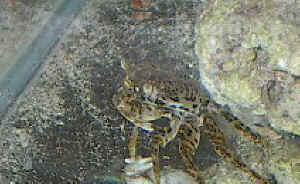 |
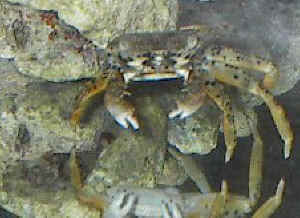 |
|
Re: Identification/HI Bob, Thanks again. I
live on the west side of Oahu, specifically an area called Royal
Kunia. I do not dive, but I have some friends that
dive on a pretty regular basis. They usually dive on
the North shore near Kahuku. <Yikes, but not in winter! Have
been around the corner from there at Shark's Bay> Please
feel free to contact me if you have any more
questions. Mahalo, Jeff <Mahalo to you my friend.
Bob Fenner>
|
Unknown crabs - 11/25/03 I have two crabs in my aquarium. One
that has a 3cm body n the other one very small about a 5mm body. Will
they do any harm to my aquarium. <Possible, but unfortunately, by
this description, I can not help much. Here is what I would
do: I would either see if I can't identify these guys by looking
through some books, maybe do a search on the internet for
"saltwater crabs", or send us a clear picture if possible.
Any of these items will help us and you identify the species and it
requirements and habits.> I don't have many fish in my aquarium
but I don't want to add more if they will eat them. <You
don't have any fish, but you don't want to add more?????
Meaning you have some fish???> How fast do they grow and how do I
catch them? <Not sure how fast they grow as we have no idea what
type of crabs you have. You could try to use a trap device, put some
food in it and lay it on the bottom of the substrate. They have these
at various dry goods retailers. You could try to ID them and maybe you
will find that they are no harm at all. Good luck ~Paul> Thanx
Sarah
Liomera strawberry crab? 11/18/03 Dear Wet Web Media Crew, I
was on a website called saltwaterfish.com, and I saw a beautiful pink
crab that they called a Hawaiian Strawberry crab. It was
currently sold out, and they said it was very rare in home
aquariums. <a good selling point even if untrue
<G>> Other than that, they didn't give a whole lot of
information. I have asked some local fish store people, and
they have no idea what I'm talking about. They laugh and
think I'm nuts!! Do you have any information on this
crab? I think it's really neat and would eventually like
to purchase one. I just need to get some more information
and am having trouble finding it. Thanks a
bunch!! You guys are always so helpful! Keep up
the good work! Sincerely, Denise <There are more than a few
crustaceans around the world called "strawberry crab".. but
based on "Hawaii" and "pink" (I'm also guessing
it has white spots perhaps?), I'd guess you are looking at a
Liomera sp. Do use this genus to do a web search and see if the species
you find look similar in body shape. Once we confirm the ID of this
crab, then we can discern how to care for it. If it is a Xanthid,
though... it is likely opportunistic and omnivorous. Best regards,
Anthony>
-Scary looking crab ID- I have had this guy in my tank for
several years. He is the oldest living inhabitant. I have come to
believe that he is carnivorous and there is good reason that he is the
oldest. <Hehe, let's take a look...> He may be eating
whatever he can get his claws on! My 2 most recent disappearances were
two emerald crabs. Can you help me identify him. I captured him last
night in a drinking glass trap with some food in the bottom. <Cool,
simple traps like that work the best.> He is now in a plastic
container in my refugium. <Well, it appears to be some sort of a
shame faced crab, not usually reef safe. I wouldn't reintroduce him
back into the tank, but if you replace the missing critters and they
disappear again, then it probably wasn't him... A good suspect
nonetheless. Good luck! -Kevin> Thanks, Joel
| Hazardous Hitchhikers? Once again I am in
need of your great expertise. I have always regarded all of my
worms as no biggie as you often recommend. However I seem to think
this guy was a bad one. Here are some pics of the chopped up
(during removable not intentional) worm. It was maybe
3 inches or so all together. Also a close up of the
mouth parts on my new pc scope . Also Since I believe this is a
single worm if it is bad should I be concerned that there are more
and if so how should I remove? <It looks to me to be a bristle
worm of some sort...Possibly a Eurythoe species...Most likely
harmless, and an efficient scavenger. Unless you notice collateral
damage to sessile inverts in your tank that can be traced to this
worm and his pals, I wouldn't be overly concerned. Many are
highly over-rated as "threats", IMO. If it makes you feel
any better, you could "employ" a Banded Coral Shrimp
(Stenopus hispidus) to help keep the population in check, but they
can be a bit feisty themselves!> Next while dismantling the rock
he was in I found this crab. A obvious hitch hiker he has been in
the reef tank nearly a year unnoticed. I want to know if he is safe
for my reef tank. I have some larger shrimp and fish as well of
course. He is maybe 3/8ths of an inch right now. Also I
have him in a different tank with very few rocks so if better pics
are needed or I must get rid of him I can find it easily. <Well,
based on the picture, I can make a reasonable guess that he is some
sort of Xanthid Crab, which is generally a commensal species
founding corals. Most are harmless, but it's hard to say for
sure...I'd err on the side of caution and provide him a nice
section of refugium or a place in a nano-reef of his own to
forage...> Thanks for any help. I appreciate all of your input.
Have a great day or evening. Shane <Thanks, Shane. I would not
go crazy over these hitchhikers...All part of the amazing diversity
in our reef tanks! As long as no harm is being done to your other
specimens, I'd simply observe them closely and enjoy their
appearances when you see them! Regards, Scott F> |
|
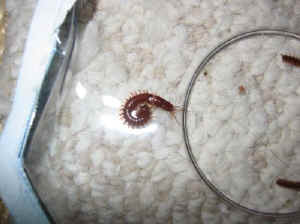 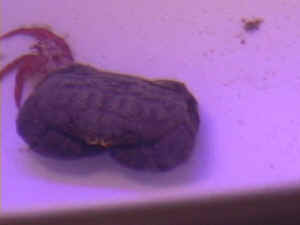
|
-Crab ID- Dear WetWebMedia Crew, Thanks for
all of the information on your web site. This web site
has been a great resource for all my questions to set up my mini
reef tank. <Excellent!> Recently, I have purchased some Fiji
live rocks from Petco and got a small orange crab with several
polyps on it. I'm unable to find any information
regarding this crab at all but he is a nice crab and I want to know
more about him. <How cool is this guy?! Although you got it on a
piece of live rock of pacific origin, I believe it to be a
Caribbean decorator crab (Leptopisa sp.). As far as I knew they
weren't from the pacific, so it had to have been introduced
somewhere along the supply chain.> I also sent some pictures of
him along with this e-mail. I would like to know what
kind of crab he is as well as other care information.
<They're pretty easy to keep scavengers of algae and dead
thing, but may nab a small fish or two as they grow. The only
downside to them is the constant rearranging of polyps and other
things that can easily be plucked off the rocks and attached to the
back. Nice find! -Kevin> Thank you very much in advance.
Sincerely
Satha Phongsatha |
|
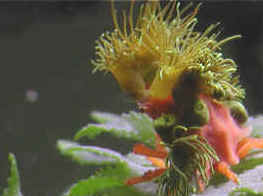
|
Crab identification Hi Bob, I just bought a piece of live
rock. <<Hello, I'm not actually Bob... hope that's
ok.>> After two days I noticed something moving in the live rock.
On closer observation I saw a couple of small crabs about the size of a
flat dog tick. They are light brown with dots on them. Do you have any
idea what I have, and should I try to get rid of them. <<I'm
not certain at all what type of crabs these are. If they really
aren't any larger than a dog tick, I wouldn't be to concerned
about them.>> Thanks, bluesky <<Cheers, J -- >>
| Crab & snail id help Hi everyone at
WWM, <cheers, mate!> lets try again, hopefully without
crashing your system. <heehee...thank you :) > here are
a couple of pictures of the hitchhikers I have. the actual snail is
a light green in colour. the picture of the crab is very dark and
is actually a tan colour. second picture is not quite as clear
because of the plastic cage, but it shows his colour better. any
ideas? do they both go or can they stay without damaging anything
in my tank. Thanks Barry <it would be unfair to say that we (or
most any aquarist) could ID these creatures down to the species
level. Even genus for the crab if unlikely/impossible from the
image. However... I can tell you that the are both likely
omnivorous. In the case of the crab I am quite certain that it is
likely unsafe with many invertebrates and small fishes. One of the
"rules" with crabs is dark or black tipped claws and/or
hairy carapaces mean trouble in reef tanks. I personally am not
comfortable with most any crabs. By and large they are all
opportunistic creatures. My advice is to pull both to a fishless
refugium or remove altogether. Best regards, Anthony> |
|
Crab ID Hello, Can anyone give me an ID On this crab?
<Hmm... not so easy from the bottom side of the crab.>
I'm trying to get a better pic. <That would help.> But
some suggested Sally Lightfoot, but this one has a bulky body.
<Could be a Mithrax... but really not 100% certain.>
Thanks, Tim
<Cheers, J -- >
|
|
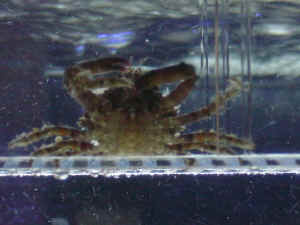
|
Name that crab Hi Bob <<Hello - you got JasonC this
time.>> I've got a couple of crabs that the local pet shop
refers to as freshwater king crabs. <<I did some searching on the
Internet using this moniker... didn't come up with much.>>
They are reddish brown about an inch and a half across, flat with even
sized claws with serrated backs. Any clues what they might be?
<<Could they be... this crab? Sesarma bidens - the red clawed
crab - here's a URL with some photos which may [if you and I are
lucky] match up: http://wrongcrowd.com/aquaria/crab/ If
that's not it, then I need to keep looking, let me know.>>
Steve <<Cheers, J -- >>
Re: name that crab Hi Jason <<And hello to you.>>
Thanks! but nope I got a couple of RCCs in there some fiddlers and a
couple of burrowing Cray fish but these are about 3 times the size of
the RCCs and much more flattened dorso ventrally. Any more clues
I'd be glad to hear em <<Alright then... I'll keep
looking.>> thanks again Steve <<Cheers, J -- >>
MYSTERY CRAB Bob, <Steven Pro this morning.> I have
been enjoying your web site and the posted e-mails and thought you
might be able to help me with a crab ID. I purchased 27 lbs of Fiji
live rock a while back and made one of those amazing discoveries, I
believe you called it the "Trojan crab." <Yes, very
common.> After my hermit ate away a wall of algae I noticed this
weird set of legs sticking out of one of the crevices. At first I
thought one of my hermits went extravehicular on me so I accounted for
the two I had. I was then trying to figure out how in the world a
spider could get in my tank, since that was what the legs looked like
and I could not see the carapace. Then it moved and pretty much ruled
out the dead spider theory. Since then I have been able to get a better
look at it and it is definitely a crab. The body color is sort of a
grayish green, maybe a little mottled. The carapace is only about
1/2" (estimated), and it has two small equal sized pincers which I
have seen used to eat algae. The legs seem to be the same grayish
green, but with dark bands. An internet search led me to believe I
might have a Mithrax here, but my local pet shop accurately pointed out
that they hail from the Atlantic, not the Pacific (Fiji live rock), and
that I likely had a stone crab. I have tried to find any reference to
stone or rock crabs to no avail, other than restaurant listing....not
much help there. Any ideas on what kind of a present I received? <I
have no good guess on ID from your description. There are many, many
crabs that come in as hitchhikers. You may want to try searching
through several good books. The Baensch's Marine Atlas's are
excellent.> Should I be worried and have it evicted? <If you have
a sump, I would definitely remove and relocate it to there.> Thanks
in advance for your help and I look forward to visiting your web site
again. Sincerely, Mark
<Have a nice weekend! -Steven Pro>
| Crab ID Hey guys, <cheers, mate> I a
couple of photos of a crab which was a stowaway on some live rock I
got about a year ago. He survived both the shipping and the curing
process. In fact, I didn't see it for over three months but now
he has molted 3 times and regularly makes appearances. However, I
think he has been eating my snails??? <this crab like most
is not only a possible candidate... but a likely one. They are
opportunistic predators... leaning towards carnivores ;) > Is
that possible? <does a bear bring a Reader's digest
into the woods?> Is there anything else I should worry about and
can you tell from the picture what type of crab it might be? No ID
from the blurry photo, but they are categorically omnivorous... few
if any crabs belong in mixed invertebrate displays (reef tanks or
not)> Thanks, Jeff J <best regards, Anthony> |
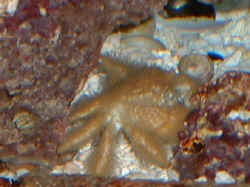 |
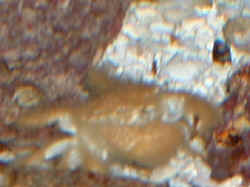 |
And a Crab, Xeniid id Hey, Bob...
I really have no clue about this crab. I read
about Caphyra laevis and C. polita being associated with or preying
on Xeniids... but have no pics of these species. Seeing other
Caphyra though... they look more like your crab to me
Lissocarcinus. Sorry I couldn't be of more help here :(
Antoine
<Thanks... will try to look up the genera you mention.
Bob> |
|
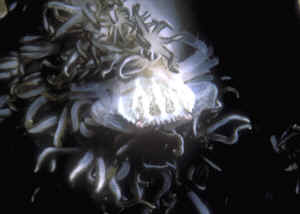
|
|
|

